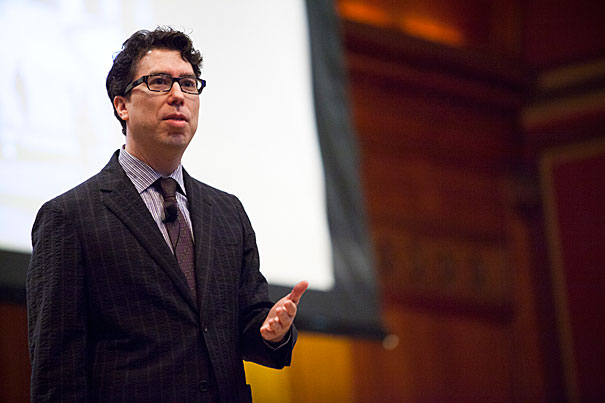
Jonathan Zittrain: “What makes some thoughts more worthy for .edu to do, and others for .com to do, or is it just a matter of who gets there first?”
Stephanie Mitchell/Harvard Staff Photographer
Taking stock of technology
IT summit draws 1,000 from across the University
At the recent Harvard IT Summit, Anne Margulies, vice president and University chief information officer, mentioned how Harvard had been at the forefront of information technology since its inception, even to the point of naming the burgeoning field. Quoting from a then-futuristic piece titled “Management in the 1980s” in a 1958 issue of the Harvard Business Review, Margulies noted that the article declared, “We shall call it ‘information technology.’”
“Our field didn’t even have a name until Harvard gave it one just 55 years ago,” Margulies told a crowd of about 1,000 in Sanders Theatre on June 6. “Since then, it has been ever-changing, incredibly rapidly, and increasingly important to everything we do … And as a result, we have some of the most exciting, challenging, and rewarding jobs on the planet.”
The summit’s keynote speaker was Jonathan Zittrain, professor at Harvard Law School, Harvard Kennedy School, and the School of Engineering and Applied Sciences, as well as the co-founder of the Berkman Center for Internet and Society at Harvard University. He devoted his lecture to the potential “end of .edu.”
Zittrain recalled the words of Jonas Salk, who developed the vaccine for polio while a researcher at the University of Pittsburgh. Asked about a possible patent for his discovery, Salk declared that the people owned it, much like they owned the sun. Salk said “there (was) no patent” for the vaccine.
For Salk, Zittrain said, the greatest honor was to make advances in his field and to see them have an impact to improve the world. Zittrain added that had Salk patented the vaccine, it would have been worth approximately $7 billion to the University of Pittsburgh in today’s dollars.
By contrast, Zittrain cited the example of Lipitor, a medication developed by a pharmaceutical company to lower cholesterol. Since patenting the drug 12 years ago, he said, Pfizer has earned $125 billion from Lipitor sales.
“This raises an interesting question: What is the locus for great thoughts and innovation that have an impact on the world?” Zittrain asked. “What makes some thoughts more worthy for .edu to do, and others for .com to do, or is it just a matter of who gets there first?”
In fact, Zittrain said, the worlds of .edu and .com have been blending for decades. The co-transformation of eukaryotic cells, which allow researchers to inject foreign DNA into a cell and manipulate cells to accept it, was discovered by Columbia University researchers. The idea to patent the discovery, Zittrain said, “came from one of the co-inventors, Richard Axel, and it struck his other co-inventor as a rather odd thing to do.”
But by working with offices at the university that fall within the .com model — offices that work closely with patenting, marketing, and promotion — university research can result in enormous profits for an academic institution. The case discovery of eukaryotic cels, Zittrain said, resulted in $790 million in licensing fees to Columbia University.
Zittrain said that the core purposes of educational institutions such as Harvard should be grounded in four ideas: the cultivation of scholarly skills; providing access to the world’s information; freely disseminating “what we know and transform from what we then learn”; and contributing “actively and fiercely” to the development of free information on “open, unowned information platforms” such as the Internet.
“But I think there is some value in separating threads that become a little too intertwined with values,” Zittrain said.
“If you think it’s all just cash and carry, that’s not what I think we stand for here. Money is a variable, but we’re probably not solving for it: We’re solving for the ‘Veritas’ of it … to decide how much of Jonas Salk’s tradition we want to do, and how much we want to go with another.”




